In the 1950s and ’60s motorcycle styling was of little concern to either the OEMs or consumers. Two wheels with an engine in between was the standard of the day, with minor differences in the shape of the gas tank.
Then in 1973, Triumph USA and designer Craig Vetter came up with the Hurricane, and people began to take styling seriously.
But not too seriously. By 1980 the Big Four all had big UJMs on the market, from Honda’s CB900 to Yamaha’s XS1100, which all looked roughly the same. The engines were powerful, the chassis improving, but the styling was pretty dull. Compare those to Ducati’s Mike Hailwood replica, or Laverda’s Jota—and there was a major difference.
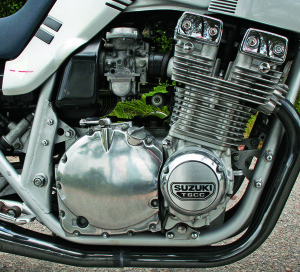
As the story goes, a newly formed Bavarian company, Target Design, was looking for business and convinced Germany’s Suzuki importer that something should be done to improve the look of a Euro-only 650/4. The importer took to the idea and hired Target to come up with some designs. Target’s primary engineer was Hans Muth, who had worked with BMW to create the R90S and R100RS. He came up with a blended look, with a small wedge-style fairing curving into the gas tank and then into a very scooped two-tone saddle. And while a traditional front fender merely curved over the wheel, an abbreviated piece with filled-in sides could not help but catch the eye of the viewer. As did the black exhaust system. Not only was the look important, but also the ability to split the air at high speeds. The café-racer look had been around for a long time, but this was a real-racer look for a bike meant to be competitive on a track. All this went back to Japan.
Suzuki’s suits liked what they saw and decided to go along with the idea. Their GS1100E, with the new 16-valve engine, was a pretty darned good motorcycle both in power and handling, but it lacked that creative concept, the sparkle that would definitely set it apart and make it distinctive. The marketing gurus felt that while the concept could get a good deal of free ink in the motorcycle magazines, it probably would not sell as well as the standard version. That’s OK; it could be a somewhat limited edition.
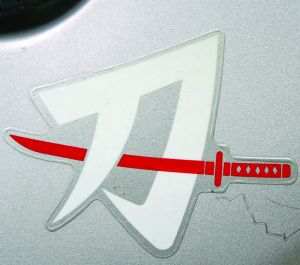
Late in 1980 at the Intermot show in Cologne, Germany, the world’s biggest motorcycle show, the GS1100 Katana was presented—to rave reviews. Viewers exulted over the idea that design had become as important as road-worthy protection (big fairings) or narrowly defined racetrack aerodynamics. But it was not to be imported into the U.S.; the American distributor apparently was a little unsettled by the radical style. The Katana sold well in Europe, and won races. Late in ’81, a second Katana appeared with a cylinder displacement reduced to just under 1,000cc, qualifying for liter-bike competition.
U.S. Suzuki took a second look and said, “Let’s try it.” The GS1000SZ (Z was Suzuki’s alpha code for 1982 models) could prove its mettle on the racetrack, since AMA rules limited superbikes to under 1,000cc. The advertised price was a reasonable $4,500, $500 more than the GS1100E, but a lot cheaper than a $6,000 Jota or $7,000 R100RS.
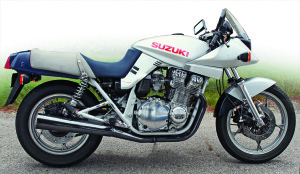
The 1100 (1,074cc in reality) had a bore of 72mm, stroke of 66mm; on the 1000 the bore had been reduced by 2.6mm, with the stroke remaining the same for a total of 998cc. A pair of chain-driven overhead camshafts operated the 16 valves, and it redlined at 9,000 rpm, using Suzuki’s much-advertised Twin Swirl Combustion Chamber system. Carburetion was through EPA-friendly constant-velocity 34mm carbs, and the fuel was compressed to a heady 9.5:1…like the 1100. When the Katana was dyno tested it produced just over 90 ponies, while the GS1100E came up with only two more. A drop in 76cc costing only two ponies…impressive engineering.
Performance shops quickly seized on the possibility of making the fast Katana go even faster. Yoshimura sold a big-bore cylinder kit which upped the capacity to 1,140cc, as well as higher performance camshafts. A few other mods and the original 90 horsepower could be upped by 25 percent. Granted, the parts and labor for such an exercise almost equaled the original $4,500 cost of a Katana, but as the hot-rodders like to say, more power is a direct product of more money.
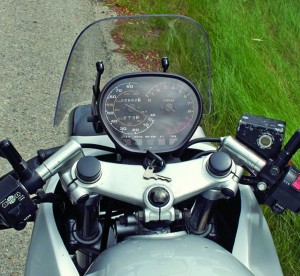
The engine was one thing, the chassis quite another. The original intent had been to create a racy-looking motorcycle, and then the developers decided to add suspension that was more at home on a smooth racetrack than a poorly maintained public road. The frame was the same double cradle as seen on the GS1100E, with a few minor modifications for the new bracketry.
The 37mm center-axle front fork had a rake of 28.2 degrees, trail of 4.5 inches. There was no air adjustability as on the GS1100E, only spring preload, but the fork did have anti-dive units on each leg, which was the rage in the early ’80s. The Suzuki system, which was not adjustable, used hydraulic damping to slow the compression on the fork springs when the right-hand lever was pulled in. Magazine test riders of the era seemed to think that the system worked OK, but rave reviews were not in order.
The shock absorbers were another matter, being on the very stiff side of stiff. These were pressurized to over 140 psi, and had twice the rebound and damping rates as on the GS1100E shocks. This was all well and good on a clean asphalt surface, not so desirable on a bumpy byway.
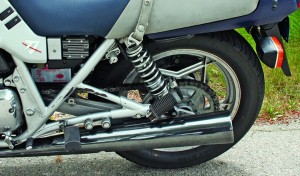
There were brake discs all around, two on the front, one on the rear, all 275mm in diameter and all using single-piston calipers. The front tire was a 3.50 x 19, rear, 4.50 x 17. Wheelbase was a tad under 60 inches.
With clip-on bars and the deep saddle, the rider was constrained, and Americans liked the comfort of high bars and a flat saddle. Above 80 mph the wind-lift made the position quasi-acceptable—but this was in the era of the federally mandated 55-mph speed limit. Lots of riders admired the 1000 Katana, and then went on to buy the stock GS1100E.
In ’83 the 1000 was dropped, replaced by 1100, 750 and 650 versions. They suffered the same fate, not helped along by the recession at the time. Unsold models were still available two years later, at a considerably reduced price. The Katana name was dropped at the end of ’83, to be temporarily revived in the late ’80s. And these originals are now quite collectable.
(This Retrospective article was published in the September 2012 issue of Rider.)








I’ve owned two, an ’82/1000 and an ’83/1100. They look alike and are completely different. The ’82 was a wild animal with a handlebar vibration that would kill your hands until we figured out to move the front turn signals. But for a long, heavy motorcycle it was a rocket. The ’83, with the modded GS1100 motor is a pussycat by comparison. But if you don’t want to see your machine coming at you on the road – or hardly anywhere – it’s a good bet. By the way, my ’82 got stolen….